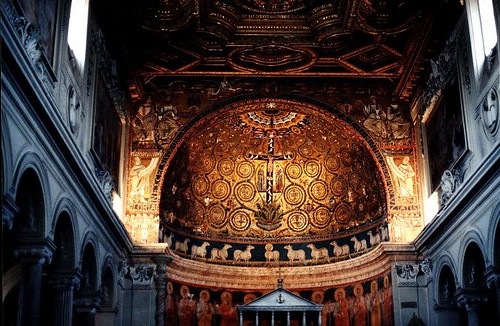
San Clemente’s absolutely fascinating excavations draw visitors from all over the world. Being able to visit a 12th century basilica is pretty amazing all on it’s own for any American, however, being able to go down into an excavated 4th century basilica and two 1st century B.C. buildings is worth the 5 euro price of admission. I took this photo from this angle to catch the Coliseum in the background to the left.

San Clemente, a minor basilica, is entered off of Via di San Giovanni in Laterano. It was built in 1108, completed in 1123. Let’s just say the curb appeal leaves a lot to be desired. There’s no display of unique external architecture that would capture anyone’s attention to the current church. It’s pretty low-key and very hard to photograph. What is found inside is far from ho-hum and unfortunately, no photos are allowed to be taken, so I borrowed from a few online sites.
Upon entering the basilica, you are greeted by three basic naves in a rectangular shape, supported by unmatching columns – some appear to be granite, others Corinthian marble. The floors are a colorful marble, not in a complex design, but then there is a stunning spiral candlestick, striped in a colorful, glittering mosaic, which sits above the 6th century schola cantorum (choir enclosure) which was moved up from the 4th century basilica below.

Look left and Gasp! The apse… The apse is covered in a beautiful, intricate gold mosaic, depicting the Triumph of the Cross. The decorative details of animals and plants are amazing. Being a good rule follower, especially since I’m on foreign soil, I didn’t dare take a photo, but I really wanted to!
The sacristy contains the ticket office and stairway down into the excavations.
We walked down into the very well preserved basilica, which historical writings have referenced as it being dedicated to Pope Clement I (who was either the 2nd or 3rd bishop of Rome after St. Peter) in 392. There we found the second largest collection of Early Medieval frescos in Rome, depicting pieces of stories of Mary, Jesus, St. Clemente, St. Alexis, Pope Leo IV, and empress Theodora – all painted throughout the 5th and 9th centuries. The paintings that were restored are of good color, but faded. The walls were made up of bricks, old bits and pieces of columns, and other broken, carved pieces of marble. Again, I wish I could have taken a photo!

A fascinating painting is the Legend of Sisinnius, as it contains one of the oldest examples of painted language in classic Latin AND vernacular Italian. It’s dated at approximately the 11th century. (This photo is from www.sacred-destinations.com)
The largest collection of Early Medieval frescos can be found in the Roman Forum at Santa Maria Antiqua, which isn’t currently open to the public as it’s undergoing extensive excavations (i.e., will open in the next 25 or 50 or 75 years...)
Christianity became legal in Rome in 313, and many churches were immediately built, but other pagan churches were legal until 391.
 |
So under this site was previously a large Roman home and Temple of Mithras. There are many legends around whom the home belonged to, the most popular legend being San Clemente. The home was a series of bricked rooms, with low doorways (these people were short!) connecting each room. The ancient Roman waterway, still flows through a room in the house – very cool. (This map is of the ancient Roman aqua ducts. Number 10 is about where San Clemente is located.) Also legend, Christians would worship secretly during the 2nd century on this site.

Then, in the late 2nd century, the Temple of Mithras was built on the site. The Mithras were an all-male fertility cult, originating from Persia in 1st century B.C., and they were rivals of Christians from 14 – 313 A.D. Much of the Temple was destroyed when the 4th century basilica was built. One room remains, which we couldn’t enter. It contains a marble Mithraism altar, marble chairs, a painting we couldn’t see and supposedly, stars on the ceiling – again, we couldn’t see them, just the altar. (This photo is from www.livius.org)
Due to religious persecution, the Irish Dominican’s were granted San Clemente and San Sisto Vecchio to administer and live out their religious lives. They continue that mission today.
In 1857, Father Joseph Mullooly began the excavations in San Clemente and within 10 years, the 4th century basilica had been excavated.


There are countless ancient churches in this neighborhood, as it is the adjoining neighborhood to the first Vatican – Basilica San Giovanni in Laterano (my amateur photos above). All of the Pope’s were crowned here until 1870 and before the Pope’s moved briefly to Avignon, France, in 1309, this also was the papal residence. We certainly have a lot more exploring to do!


No comments:
Post a Comment